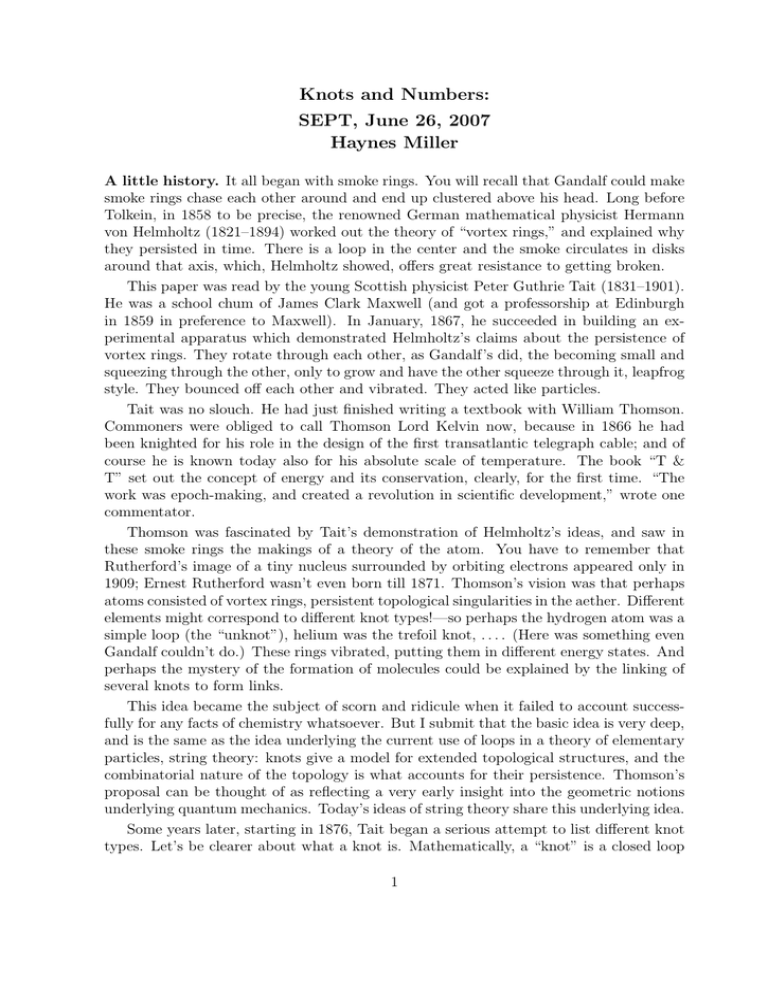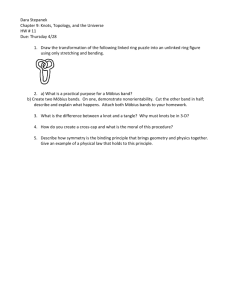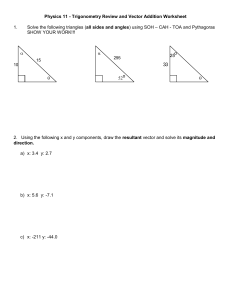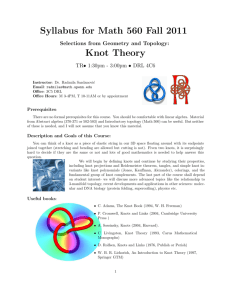Knots and Numbers: SEPT, June 26, 2007 Haynes Miller
advertisement

Knots and Numbers:
SEPT, June 26, 2007
Haynes Miller
A little history. It all began with smoke rings. You will recall that Gandalf could make
smoke rings chase each other around and end up clustered above his head. Long before
Tolkein, in 1858 to be precise, the renowned German mathematical physicist Hermann
von Helmholtz (1821–1894) worked out the theory of “vortex rings,” and explained why
they persisted in time. There is a loop in the center and the smoke circulates in disks
around that axis, which, Helmholtz showed, offers great resistance to getting broken.
This paper was read by the young Scottish physicist Peter Guthrie Tait (1831–1901).
He was a school chum of James Clark Maxwell (and got a professorship at Edinburgh
in 1859 in preference to Maxwell). In January, 1867, he succeeded in building an experimental apparatus which demonstrated Helmholtz’s claims about the persistence of
vortex rings. They rotate through each other, as Gandalf’s did, the becoming small and
squeezing through the other, only to grow and have the other squeeze through it, leapfrog
style. They bounced off each other and vibrated. They acted like particles.
Tait was no slouch. He had just finished writing a textbook with William Thomson.
Commoners were obliged to call Thomson Lord Kelvin now, because in 1866 he had
been knighted for his role in the design of the first transatlantic telegraph cable; and of
course he is known today also for his absolute scale of temperature. The book “T &
T” set out the concept of energy and its conservation, clearly, for the first time. “The
work was epoch-making, and created a revolution in scientific development,” wrote one
commentator.
Thomson was fascinated by Tait’s demonstration of Helmholtz’s ideas, and saw in
these smoke rings the makings of a theory of the atom. You have to remember that
Rutherford’s image of a tiny nucleus surrounded by orbiting electrons appeared only in
1909; Ernest Rutherford wasn’t even born till 1871. Thomson’s vision was that perhaps
atoms consisted of vortex rings, persistent topological singularities in the aether. Different
elements might correspond to different knot types!—so perhaps the hydrogen atom was a
simple loop (the “unknot”), helium was the trefoil knot, . . . . (Here was something even
Gandalf couldn’t do.) These rings vibrated, putting them in different energy states. And
perhaps the mystery of the formation of molecules could be explained by the linking of
several knots to form links.
This idea became the subject of scorn and ridicule when it failed to account successfully for any facts of chemistry whatsoever. But I submit that the basic idea is very deep,
and is the same as the idea underlying the current use of loops in a theory of elementary
particles, string theory: knots give a model for extended topological structures, and the
combinatorial nature of the topology is what accounts for their persistence. Thomson’s
proposal can be thought of as reflecting a very early insight into the geometric notions
underlying quantum mechanics. Today’s ideas of string theory share this underlying idea.
Some years later, starting in 1876, Tait began a serious attempt to list different knot
types. Let’s be clearer about what a knot is. Mathematically, a “knot” is a closed loop
1
sitting in space in some way. Two knots are “the same” if one can be smoothly deformed
to the other without ever crossing through itself. This operation is called a “regular
isotopy.” A “link” is a finite collection of nonintersecting embedded loops, so a knot is a
link, and there is also the empty link.
Tait studied knots by drawing projections onto a plane. You can always arrange that
this projection is free of cusps, tangencies, and points where three strands meet; this
is then called a “knot projection.” Tait published a correct and complete list of knots
which can be presented using 7 or fewer crossings.
By the way, being Scottish, Tait was interested in golf, and in fact wrote a definitive
account of the physics of golf. In most of the world he is known as the father of Freddie
Tait, two time winner of the Open Golf Championship.
Some further notes on history: The term “topology” (or rather its German equivalent “Topologie”) was dreamed up in 1836 by Johann Benedict Listing (1808–1882).
Listing was a student of Gauss, and besides his scientific talents he was something of a
logodædalist. He is responsible also for the word “micron.” He adopted many of Gauss’s
interests—in geodesy, magnetism, and in what Gauss called “Geometria Situs,” or “the
geometry of position.” Gauss was following the title of a paper published in 1736 by
Leonard Euler (1707–1783). Euler was, as you recall, the most prolific mathematician of
all time; much of the approach taken in today’s calculus courses stems from his writings,
for example. In this paper he described the “Königsberg bridge problem”: Is it possible to tour the city in such a way as to cross every bridge exactly once? This was the
founding question of the field of graph theory.
The term didn’t achieve acceptance till much later, incidentally—Henri Poincaré,
often cited as the father of the subject, still referred to “Analysis situs” at the turn of the
century. It didn’t become standard until it was advertised by Solomon Lefschetz from
his stronghold in Fine Hall at Princeton University, where much of the subject as we
know it today was created. He wrote a book in 1930 called Topology, and the world soon
followed suit.
Another good illustration of the idea of topology is given by the “Möbius band,”
whose properties were discovered and published by Listing independently and somewhat
earlier than by August Ferdinand Möbius (1790–1868). Whatever we choose to call it,
this is a band with a twist in it. This twist persists under deformation; it is permanent,
a more basic feature of the shape than any measurement. The number of twists—zero
or one—is in effect a quantum number; it is a discrete and rigid property of a flexible,
stretchable object. This is a characteristic of the study of Algebraic Topology.
Knots. Tait and his contemporaries had no idea how to actually prove that the knots
they wrote down couldn’t be deformed into each other, and it was only well into this
century that enough algebraic topology was developed to address these questions.
A cat has just come into my life, and in consequence I have some very tangled bits
of yarn around the house. I know that they were originally “unknots” (topologists’ yarn
always comes in closed loops) but I’ll be damned if I can return it to that state now.
How do I know, then that my evil neighbor didn’t slip in and substitute a knotted bit
2
of blue yarn? If I suspect that someone did, how could I prove, in a court of law, or to
my colleagues here at MIT, that this thing could NEVER be returned to a simple loop?
You need some “invariant,” which takes on one value for the unknot and another for this
one.
To say it differently, what if I give a trefoil of yarn to my cat for a few days and then
simplify the resulting tangle. How do I KNOW that it won’t come out the unknot?
The trefoil and its mirror image present another problem. If we put a mirror behind
our knot and look at the image of the knot in it, we see what might be a different knot.
The shape is the same but the crossings are reversed. The mirror image of the trefoil
is different from the original trefoil: the trefoil is “chiral,” in contrast with the figure
8 knot, which is “amphicheiral”—a good spelling word introduced in 1904 by William
Thomson—or “achiral.” Here’s a property of knots which is clear and distinct, but very
hard to guess in advance. The mirror image of K is written K.
Given two knots I can cut each and splice the open ends together. This is an example
of a general geometric operation called “surgery,” and the result is the “sum” of the two
knots. It’s not quite well-defined yet though: I need to decide which ends to splice. This
is resolved by giving the knots an “orientation.” Once again, reversing the orientation
might or might not result in an isotopic oriented knot (though the first examples of this
were only given in 1964). 817 is the first non-reversible knot, and the knots you get by
tying two 817 ’s together in the two possible ways are distinct. The reverse of K is written
−K.
A knot is “prime” if it can’t be written as a nontrivial sum. (To make the analogy
with numbers better we should speak of the “product” of knots rather than their “sum.”)
A feature of numbers is preserved: an oriented knot is a sum of prime oriented knots
in a unique way (up to order of course). So people (starting with Tait) make tables of
prime knots. The table on the back of this handout lists all the prime knots of 8 or fewer
crossings. It does not carry complete information, though; it does not indicate whether
K is isotopic to −K, K, or −K, or all of them, and it does not display K̄ even if K is
chiral.
The number of distinct prime knots goes up very rapidly with the number of crossings
in its most efficient projection. In this tabulation again K is considered equivalent to
−K, K, and −K.
Crossings
3 4 5 6 7 8 9 10
Prime knots 1 1 2 3 7 21 49 165
11
12
13
14
15
552 2176 9988 46872 253293
Here’s a partial list of the kinds of applications knot theory has had.
Biology: DNA forms coils and supercoils, and understanding them has exercised some
of the best knot theorists in the country. An exotic example: Trypanosomes are parasitic
protozoa causing deseases in humans and farm animals such as sleeping sickness and
leshmanaisis. They belong to the order Kinetoplastida, named after a characteristic
organelle called the kinetoplast. This contains DNA and replaces in these cells the
mitochondria found in most other eukaryots. A good source is
3
http://www.med.sc.edu:85/lecture/trypanosomiasis.htm
The DNA in this organelle turns out not to be formed into long supercoiled chromosomes,
but rather into some 10,000 small linked circles.
Chemistry: Polymers form knots. Symmetries are especially important.
Physics: Here is the strongest interaction, linking Feynman diagrams to mathematics
at a new depth. Also, knot theory ideas are used in Statistical Mechanics.
Mathematics: Impact in Representation Theory and Category Theory.
Rational tangles. Many mathematicians have tried their hand at the problem of classifying knots. Among them is John Conway, a great group theorist and combinatorialist.
When I first met him he was at the University of Cambridge, but he has since migrated
to Princeton. He proposed to first isolate a ball containing part of a knot he wished to
study. He demanded that the knot pierce the surface of the ball in exactly four spots. If
we fix the position of the four punctures, we have a “tangle.” Tangles are quite easy to
draw. The “zero tangle” has two horizontal lines. Perhaps it’s called “zero” because the
slope is zero. That makes two vertical lines “infinity.” “1” will be a line of slope 1 with
one of slope −1 passing under it, and “−1” is the other way around. There are some
simple moves one can do to generate new tangles from old. One can Twist: pass SE
over NE. One can Twist-inverse: pass NE under SE. And one can Rotate (in the positive
direction, by 90◦ ). Call these operations T, T −1 , and R.
Here’s a little fact you can check directly: (T R)3 = I. In checking this, you may want
to label the tangle. “F” is a good letter for this. Students don’t appreciate the letter
“F” as much as they might: it’s the first letter of the alphabet to look 8 different ways
under the symmetries of a square. Let’s label a tangle by F.
Conway noticed an amazing thing: The tangles one obtains by applying these three
operations in any order to the zero tangle can be put in one-to-one correspondence with
the rational numbers (together with ∞), in such a way that the zero tangle corresponds
to 0 and the operations on tangles correspond to operations on Q ∪ {∞}: T Translates:
T q = q + 1. R Reciprocates (both additively and multiplicatively): Rq = −1/q.
For this reason tangles obtained in this way are called “rational tangles.” One thing
one finds from this is that on rational tangles, R2 = I. (Clearly R4 = I in general,
but rational tangles have this extra symmetry.) It’s a good exercise to prove this (by
induction of course).
Given a rational number q, the way to get from 0 to q by the operations R, T , and
T −1 is to express q as a continued fraction.
Questions: 1. Any rational number is of one of three forms: odd/even, even/odd, or
odd/odd. What is the corresponding breakdown of rational tangles?
2. If K is a rational tangle with corresponding number q, what is the rational number
corresponding to the mirror image of K?
3. It’s clear that R2 q = q for rational numbers q. We thus must also have R2 K = K for
a rational tangle K. This isn’t true for a general tangle K; why is it true for rational
tangles?
4
Some references
Here are some books on mathematical in general.
William Dunham, Journey through Genius: The Great Theorems of Mathematics, Penguin, 1991.
William Dunham, The Mathematical Universe, John Wiley, 1994.
Paul Hoffman, Archimedes’ Revenge: The Joys and Perils of Mathematics.
Don Davis, The Nature and Power of Mathematics, Princeton University Press, 1993.
Some books on knot theory:
Colin Adams, The Knot Book: An elementary introduction to the mathematical theory
of knots, W. H. Freeman and Co., 1994—good elementary introduction.
Peter Cromwell, Knots and Links, Cambridge University Press, 2004—contains a treatment of rational tangles.
Continued fractions occur in any elementary number theory book, e.g.
Harold Davenport, The Higher Arithmetic, Dover, 1983.
... and a book about another wild idea of John Conway’s:
Donald Knuth, Surreal Numbers: How Two Ex-Students Turned on to Pure Mathematics
and Found Total Happiness, Addison-Wesley, 1974.
Some amusing URLs:
On mathematics: http://forum.swarthmore.edu/
On history: http://www-groups.dcs.st-and.ac.uk/ history/
On knots: http://knotplot.com
Brief biography
Haynes Miller is an algebraic topologist, so knots and numbers represent his research
interests very well. He’s a product of Long Island public schools and Harvard College.
He received his PhD from Princeton University in 1974, and worked thereafter at Harvard,
Northwestern, the University of Washington, and the University of Notre Dame, before
coming to MIT in 1986. He has two children, one a graduate student in Middle Eastern
Studies at NYU, the other a graduate student in Physics at the University of New Mexico.
When not teaching differential equations to undergraduates or learning algebraic topology
from graduate students, he may often be found traveling, frequently in search of unusual
bird species.
hrm@math.mit.edu
5






